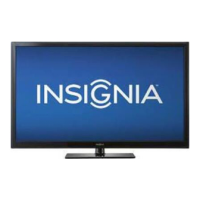13
www.insigniaproducts.com
Connecting an HDMI device
To connect an HDMI device to the back of
your TV:
1 Turn off your TV and all connected equipment.
2 Connect an HDMI cable (not included) between
the HDMI IN 1(DVI) or HDMI IN 2 jack on the
back of your TV and the HDMI OUT jack on the
HDMI device.
3 Turn on your TV, then turn on the HDMI device.
Connecting a DVI device
To connect a DVI device:
1 Turn off your TV and all connected equipment.
2 Connect an HDMI/DVI cable (not included) or
DVI-HDMI adapter (not included) between the
HDMI IN 1 (DVI) jack on the back of your TV and
the DVI OUT jack on the DVI device.
3 Connect an audio cable (not included) between
the DVI AUDIO IN jack on the back of your TV
and the DVI AUDIO OUT jacks on the DVI
device.
4 Turn on your TV, then turn on the DVI device.
Notes
Your TV may not output sound and may display
pictures may with abnormal color if the HDMI device
supports HDMI versions older than 1.3.
If there is no sound when you connect an older HDMI
device, connect the device to the HDMI 1 (DVI) jack,
then connect an audio cable to the DVI AUDIO
INjack on the back of your TV.
If this happens, contact the company that provided
the HDMI device to confirm the HDMI version, then
request an upgrade.
HDMI cables that are not 1.3-compliant may cause an
annoying image flicker or no image.
HDMI cable
Back of TV
Note
When connecting a DVI device, you must use the
HDMI IN 1(DVI) jack on the back of your TV. You
cannot use the HDMI IN 2 jack.
HDMI/DVI cable
Audio cable
Back of TV

